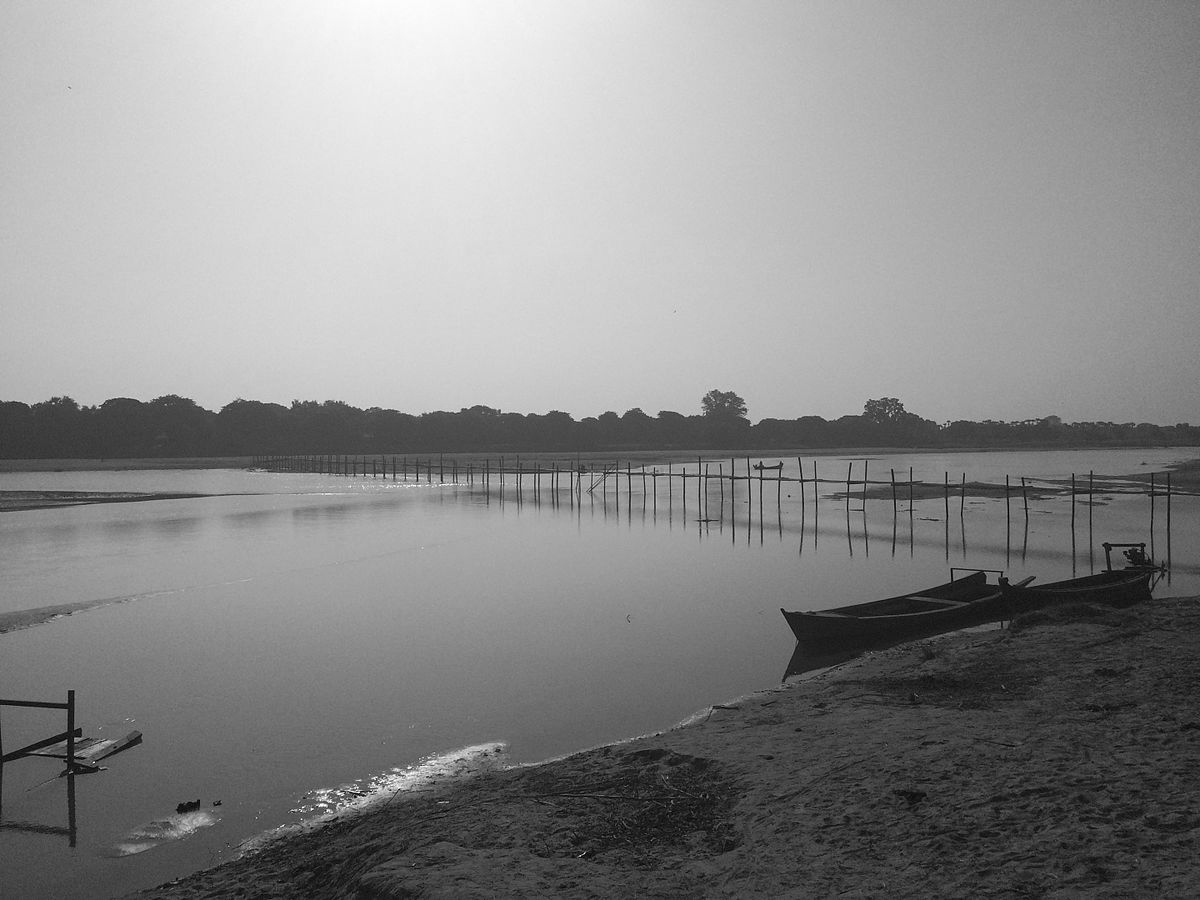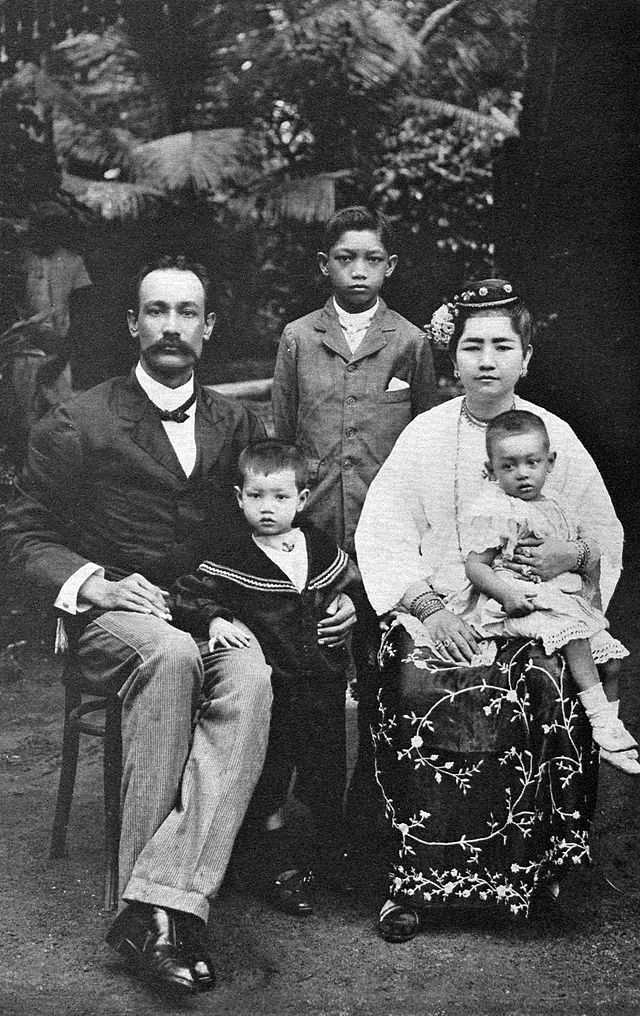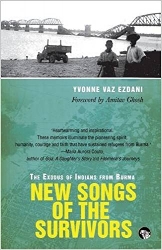By Yvonne Vaz Ezdani
The Mu River in Burma sustains many villages along its banks.
It was 1970 and I was a young student at Rangoon University in Burma. Among my many friends and hostel-mates, Cecelia D’Silva intrigued me the most. Tall, slim, and grey-eyed, she was noticeably different from the others in appearance, although there was nothing foreign in her Burmese accent or in her behaviour. She told me she came from the Bayingyi community, descendants of the Portuguese, many of whom had come from Goa several hundreds of years ago, and had settled in the Valley of the Mu River area where she lived. She also described the place as a colony of Catholics.
My curiosity was aroused.
We Goans had Portuguese connections too. I had visited Goa as a child with my family in the 1950s and I knew that it was ruled by the Portuguese. My Goan grandfather held a Portuguese passport before he took Indian citizenship. We knew a Goan family named D’Silva in Burma and they looked more brown, more Indian than European. I realised that the common factor between Goans and Bayingyis was the Portuguese, but I still couldn’t connect the dots.
I wanted to find out more about the Bayingyi people.
An Eurasian Burmese family, c. 1900. Although latter Eurasians were of Anglo-Burmese stock, the earlier Eurasians were Portuguese-Burmese. Many of the Portuguese were adventurers or mercenaries who had travelled to Burma from Goa.
Myanmar writer and historian, Than Myint-U, writes that in Burma, the “Europeans were initially labelled ‘Bayingyis’, a Burmese corruption of the Arabic ‘farenji’ [which initially referred to the French and later to all Europeans]. The word was applied mainly to the Portuguese, the European people with whom the Burmese had the most contact.” Much later on, the word Bayingyi also took on the connotation of “Roman Catholic”, but now it refers mainly to the Luso-descendants.
There was no internet in those days and most of the standard history books in the library were written from a mainstream Burmese perspective. There was some content on the Portuguese in Burma in the sixteenth and seventeenth centuries; however, most of the Burmese history of that period was about palace conspiracies and battles between kings of various states and kingdoms of Burma. There were brief references to the Portuguese pirates who roamed the coastal cities of Burma and sired “half-breeds” who were absorbed into the local population. But these descriptions did not seem to apply to the Portuguese settlers in the district of Central Burma that my friend had told me about. However, there was one Portuguese name that recurred in the books with regard to this early period: Filipe de Brito, whose Burmese nickname was Nga Zinga. What caught my attention was a reference to the Portuguese man’s strong and beautiful wife – Luísa de Brito – who played an important role in Bayingyi history. One of the books I consulted said she had been born in Goa. Again, Goa was mentioned as the place from which the Portuguese supply ships set sail to Burma. “Ah-ha”, I thought to myself – I had established the connection between Portugal, Goa, and Burma.
Strong women leaders fascinate me, and my desire to know more about Luísa de Brito has remained with me all these years. Recently, I have learnt more about her from the internet and from published books.
Painting of Filipe de Brito (source unknown). Brito, a Portuguese renegade, seized power in Lower Burma through connivance and was backed by Aires de Saldanha, Viceroy of Goa. Brito married Saldanha's niece Dona Luisa de Saldanha, who played a prominent role within the Bayingyi community.
How did she become a leader of her people? It all began with young Filipe de Brito e Nicote who came to Arakan/Rakhine, via Goa, as a cabin boy in search of fame and fortune in the 1550s. He was a shrewd charmer who did business on the side and acquired substantial wealth. His flamboyant personality caught the attention of the Rakhine king Minyazagyi, who appointed him as a palace guard. On one occasion de Brito protected the king from being killed in a palace conspiracy, and as a reward he was made Governor of Syriam. At the time Syriam, a port town, was the trade centre of Burma. Over time, de Brito became wealthy and powerful. His skilled Portuguese gunners fought battles for the Rakhine king and his network of spies helped acquire valuable information. Burma, then, was fragmented into several different kingdoms, each striving to gain more land and wealth, and Portuguese mercenaries became increasingly involved in the power struggles of the Burmese kings.
De Brito was arrogant and did not heed directives from Goa, the seat of Portuguese power in Asia. Yet, the Estado da Índia and the Church supported his self-proclaimed glory, probably because they thought he would contribute to Portuguese supremacy and conversions to Christianity in Burma. Power went to his head, and around 1602 he proclaimed himself King of Syriam. In Burma, the Portuguese mercenaries became unreliable and troublesome, causing the Rakhine king to regard them as foes rather than friends. De Brito made another enemy as well. The king of Ava, Anaukphetlun, wanted Natshinnaung, the king of Toungoo killed, but de Brito protected him in his fort at Syriam. Anaukphetlun and his army laid siege to Syriam and demanded the surrender of Natshinnaung. De Brito’s loyalty to Natshinnaung who had converted to Christianity (rumour had it that he had secretly married de Brito’s cousin) was so great that, at the cost of his own safety, he fought the Ava army and its allies. After a long drawn out siege, on March 29, 1613, de Brito conceded defeat. He was impaled on a sharp bamboo pole and, with his entrails hanging out, he was kept upright on the pole for all to see. He remained alive in agony for three days.
Archbishop Giovanni Balma, early Vicar Apostolic of the Catholic mission in Burma, c. 1848. In 1621, the king of Siam gave permission to build a Catholic Church in Ayut'ia.
At the time, many Burmese Buddhists believed that Filipe de Brito brought a curse upon himself because he desecrated the Shwedagon Pagoda by dismantling the Dhammazedi Bell. The bell was believed to be the largest ever cast in bronze, measuring about 12 cubits high by eight cubits wide. It was kept in the Shwedagon, the most sacred Buddhist pagoda in Burma. In 1608, de Brito removed the bell from the sacred site and attempted to take it on a raft from Dagon (as Rangoon was known at that time) to Syriam. His plan was to melt the bell down and use the bronze to build cannons. This was not to be. The weight of the bell caused the raft to break, sinking both. Many attempts have been made to retrieve the Dhammazedi Bell, but without success. It is believed to be under twenty five feet of mud.
The other legend associated with de Brito’s death is that he breathed his last only after his wife, the exquisitely dark-haired, golden complexioned Dona Luísa de Brito née de Saldanha arrived by ship from Goa and embraced his feet amidst the wounded and dead Portuguese littering the ground. Luísa was a broken woman in her grief. Yet, her strong personality resurfaced when she refused the Rakhine king’s advances to make her his queen; she endured the torture that followed with dignity. There were more than 2000 Portuguese captives – men, women, and children in the camp – and they all looked up to Luísa as their leader. Among the prisoners there were two priests, Father Diogo Nunes and Father Manoel de Fonseca, who kept the inmates’ Catholic faith alive. Luísa’s request to bury her husband was granted, and she was provided the resources for building a monument over his grave. This monument still stands today in Syriam, now known as Thanlyin in Burmese.
The victorious king decided to move the Portuguese prisoners from Syriam to his capital in Ava. They were made to march 500 miles and also made dangerous crossings over the Pegu River on rafts. Many died on the way and were buried on land with makeshift wooden crosses to mark their graves. It must have been sad for Luísa and the others to bury their departed family members so far from home in graves that would be erased in a short time. They knew that they too would never see home again. In his book, Cannon Soldiers of Burma (2014), James Myint Swe writes of the perilous journey between Syriam and Ava, following the historical account given by Father de Fonseca.
After their resettlement in Ava, many Portuguese men married local women and established homes of their own. Weddings were celebrated by the two priests in their group, and the intermarriages were also solemnized in Buddhist monasteries. Others stayed in the camp where they survived on the little food that was provided to them. The young, able-bodied men were made to serve in the Burmese army.
St. Joseph's Roman Catholic Church, Mandalay. The early Catholic priest who came to Burma mainly ministered to the Portuguese stationed there.
Later, the new king of Ava, Thalun, decided to free the Portuguese and gave them land. Possibly, this happened because of the outspoken courage and determined efforts of Luísa. From Ava to Sagaing, then across from the east of the Mu River to its west bank, they travelled again, filled with joy that they were prisoners no more, although there were restrictions against their departure from the country. Over the course of time, their relations with the Burmese turned friendly, making them feel more secure. Their population had now increased to nearly 2400, and they had a place to call home. They first built a small church, and then the elders marked out plots for individual houses. Luísa named their settlement Rio Aldeia – village by the river. Some families established villages at other points along the Mu River, which led into the Two Rivers Valley. There were more inter-marriages with Burmese from neighbouring villages and, in a few years, the Portuguese settlers became culturally Burmese though they remained loyal to their Catholic faith and traditions. King Thalun sent them money to build churches and invited priests from Portugal, France, and Italy to conduct religious services there.
The Portuguese/Bayingyi soldiers who served in the Burmese army were now considered loyal subjects. They were no longer mercenaries or mere captives. For four hundred years, their descendants continued to serve as valued cannon-operators and gunners who defended the Burmese kingdom patriotically. Centuries later, when the British invaded Mandalay Palace in 1885, the Bayingyi soldiers defended the ruling King Thibaw until he ordered them to surrender.
Luísa de Brito, the matriarch, lived well into her seventies and was mourned by all the Bayingyi villagers when she died. Her indomitable spirit was remembered by the Bayingyi people for many centuries. Probably because of his wife’s legacy, Filipe de Brito is still regarded as a hero among the Bayingyi people. Hero or renegade, de Brito lives on in Burmese history books and Bayingyi oral history.
The Luso-descendants of Burma have defied the loss of their identity and continue to live in the area along the Mu River, their main occupation being fishing and rice cultivation. Through oral transfer of knowledge, from one generation to the next, they are aware of their origins and, although they have adopted Burmese surnames along with their Christian given names, they still practice their Christian faith in a predominantly Buddhist society. Many of the Bayingyis are proud of the fact that they bear European features. Today, there are a number of Catholic priests and bishops from the Bayingyi community. Old baptism records and names on gravestones in the region bear Portuguese surnames. Though no one there speaks the Portuguese language any longer, some Portuguese hymns are still sung at church services. As in the old days, a spirit of solidarity prevails among the Bayingyi villagers – everyone is the other’s cousin, uncle, or aunt. Harvesting and threshing of paddy is still done as a community and the produce from the fields is shared among them. Sausages and a few sweet dishes that the Bayingyis make are similar to those made in Portugal and Goa.
I have no idea where my friend Cecilia is. I only know she married her Goan boyfriend – a D’Souza – and later went abroad. I would not be surprised if they reside in Portugal now.
Sources
James Myint Swe, Cannon Soldiers of Burma (Canada; 2014). Swe is a Bayingyi who migrated to Canada. Certain facts presented in the above article have been verified by Yvonne Ezdani through correspondence with James Myint Swe.
Thant Myint-U, The Making of Modern Burma (Cambridge University Press; 2001).
Luis Nestor and Joaquim de Castro, Bayingyi, The Hidden Face of Burma (Youtube; 2012), a documentary on the Bayingyi sponsored by the Macau International Institute.
Images featured courtesy of Wikipedia Commons.
Yvonne Vaz Ezdani lives part of the year in Goa and the rest of the time in Brisbane, Australia. She grew up in Burma/Myanmar and has many memories of the beautiful land. She has authored two books, Songs of the Survivors (Goa1556;2007) and New Songs of the Survivors (Speaking Tiger;2015). After fulfilling careers as a teacher and later as a school counsellor, she now devotes her time to writing and taking care of her grandchildren. She still finds time to nourish her soul with reading, music, and gardening.
News Songs of the Survivors can be purchased here.






